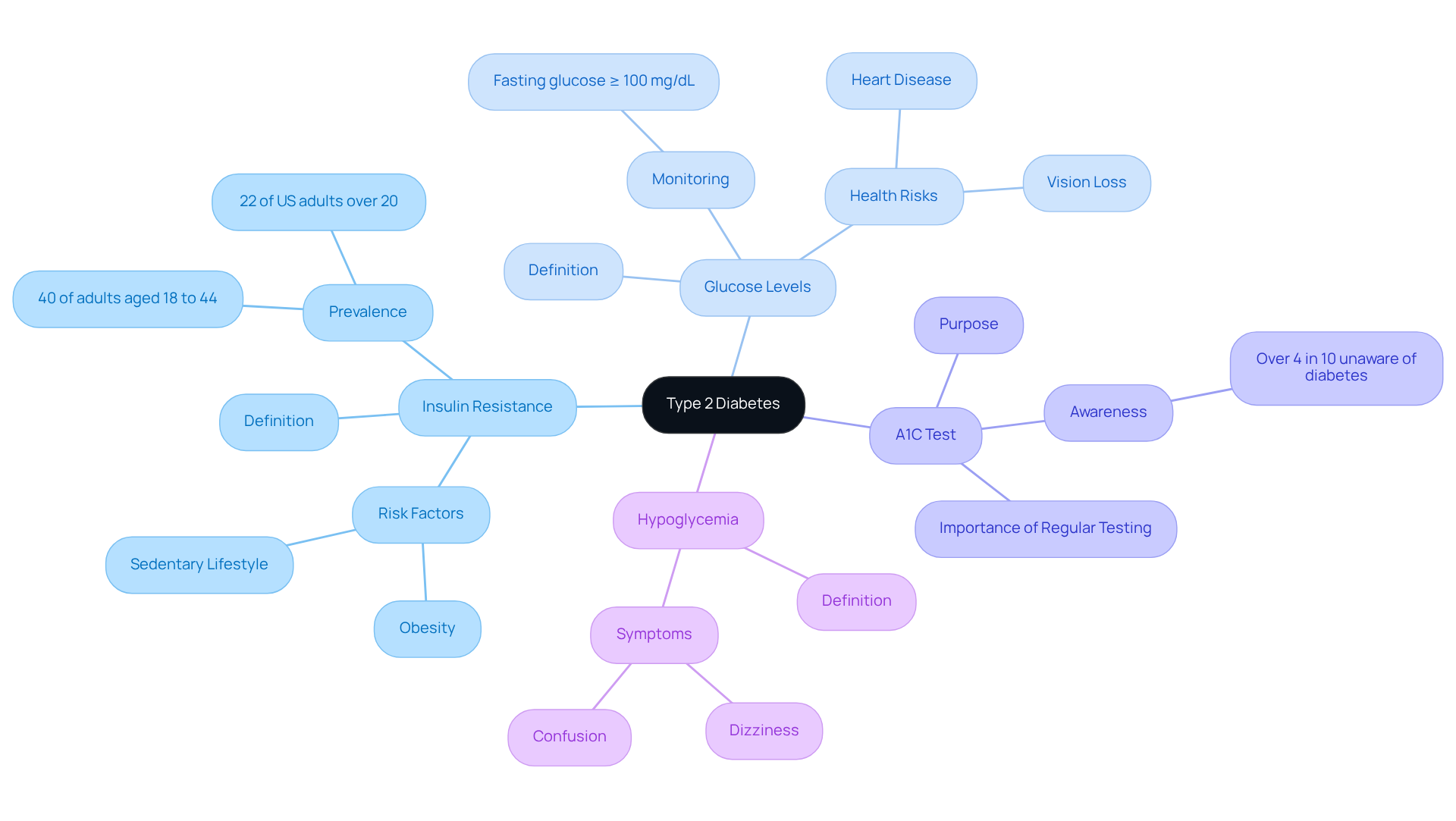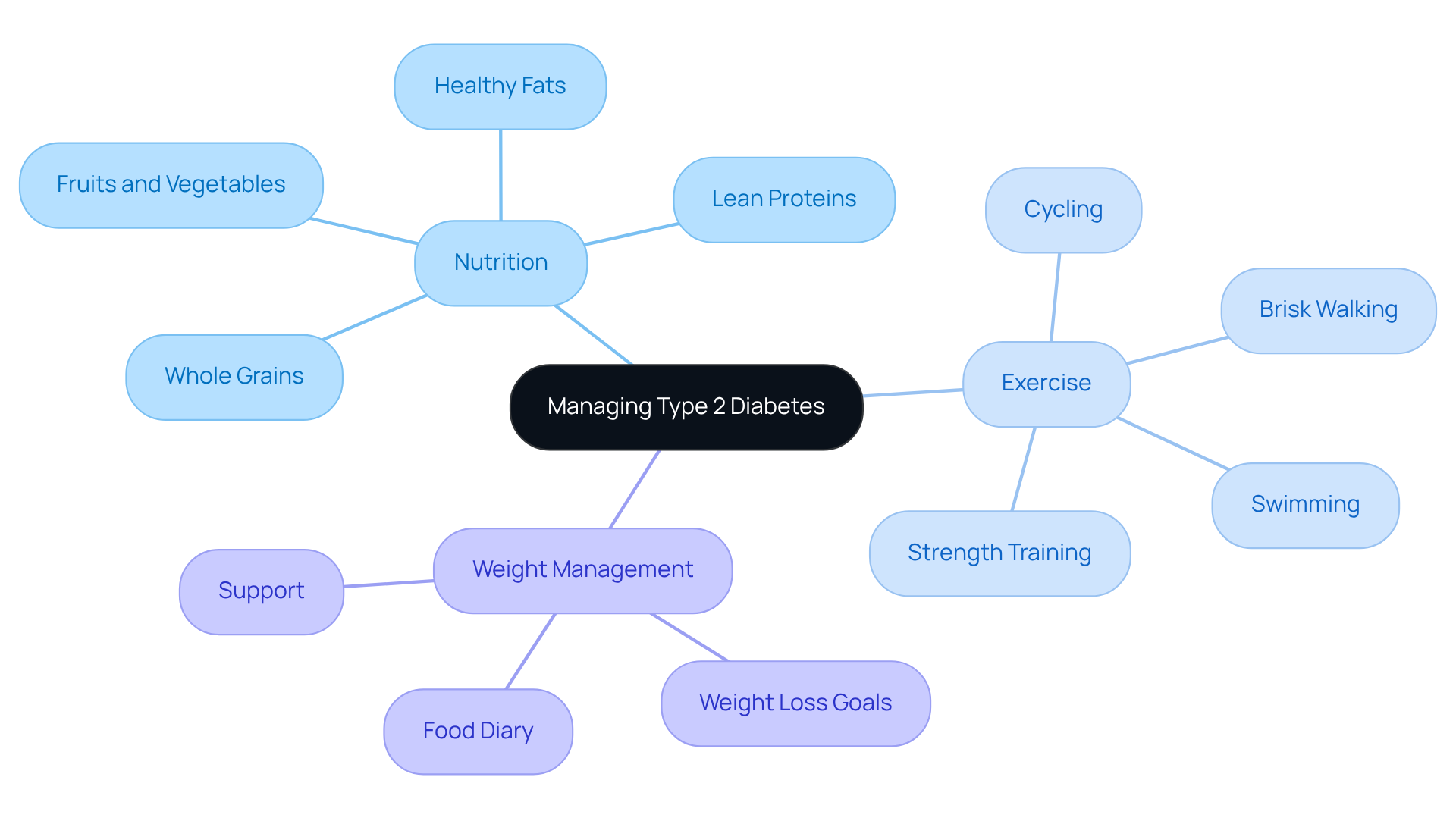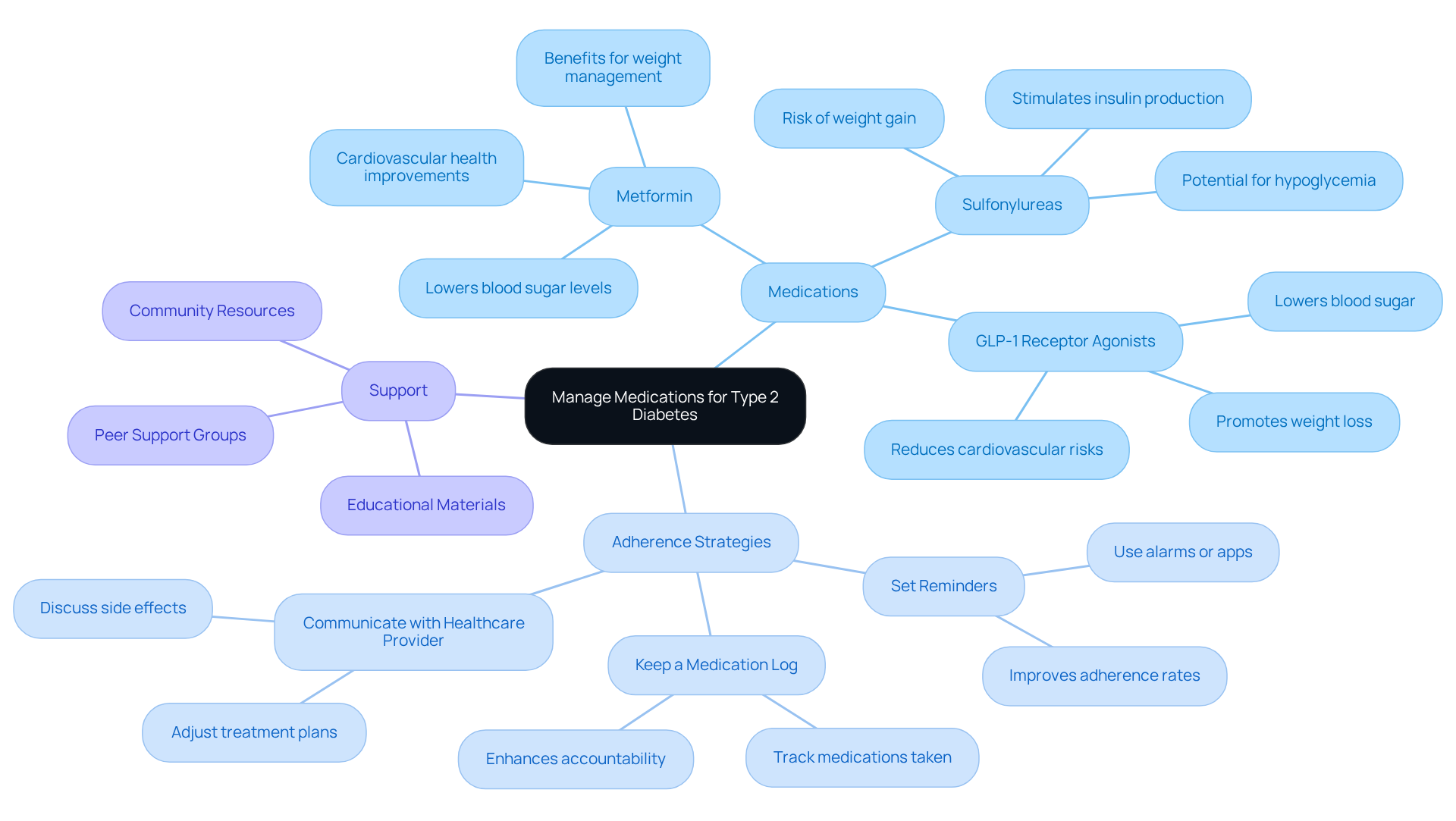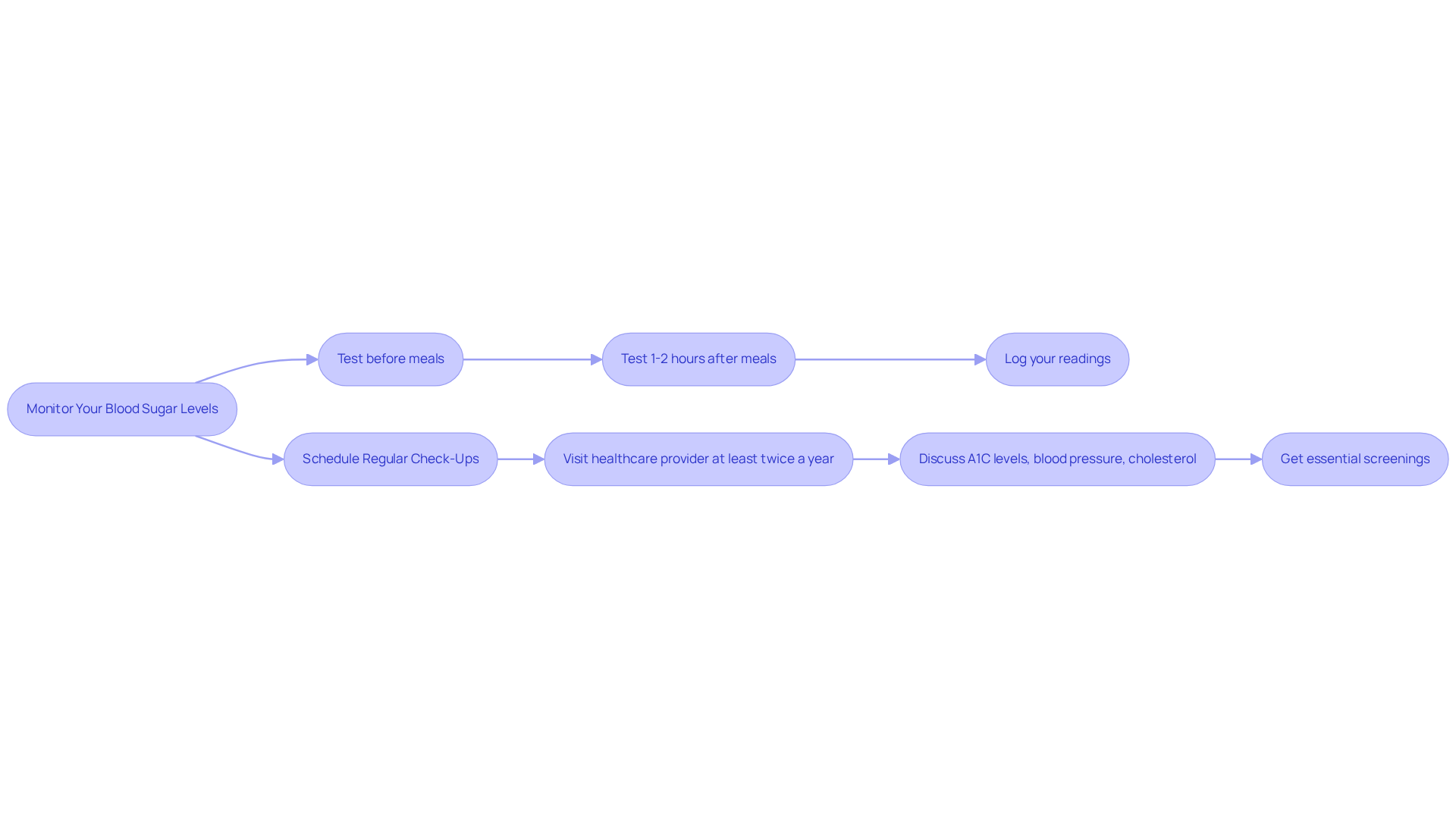Overview
Managing Type 2 Diabetes can feel overwhelming, but you’re not alone in this journey. This article outlines four essential steps to help you navigate your path to better health:
- Understanding your condition
- Implementing lifestyle changes
- Managing medications
- Monitoring your health
Each step is backed by practical advice and evidence that can empower you.
First, understanding Type 2 Diabetes is crucial. It’s important to know how this condition affects your body and what you can do to manage it effectively. Nutrition and exercise play a vital role in improving insulin sensitivity, making these lifestyle changes essential for your well-being.
Next, making lifestyle changes can seem daunting, but small steps can lead to significant improvements. Focus on incorporating healthy foods into your diet and finding enjoyable ways to stay active. Remember, every little change counts, and we are here to support you every step of the way.
Managing medications, such as Metformin, is another key aspect. Understanding your medication options can help you feel more in control of your health. Don’t hesitate to discuss any concerns with your healthcare provider; they are there to support you.
Lastly, regular health check-ups are necessary to monitor your blood sugar levels and prevent complications. It’s understandable to feel anxious about these appointments, but they are an important part of your journey toward better health. By staying proactive, you can take charge of your diabetes management.
Remember, you’re not alone in this journey. Each step you take is a step toward a healthier future, and there are resources available to help you along the way. Don’t hesitate to reach out for support, whether it’s from friends, family, or healthcare professionals. Together, we can navigate this path to wellness.
Introduction
Understanding Type 2 Diabetes is crucial in a world where millions are affected by this chronic condition. It's understandable to feel overwhelmed by the complexities of treatment options, dietary choices, and medication adherence. However, with the right knowledge and lifestyle adjustments, you can significantly improve your health outcomes and manage your diabetes effectively.
What are the essential steps you can take not just to survive, but to thrive with diabetes? By exploring these steps, you can find clarity and support in your journey. Remember, you're not alone in this journey; we are here to support you every step of the way. With compassion and understanding, let’s navigate this together.
Understand Type 2 Diabetes: Key Concepts and Terminology
Type 2 Diabetes is a long-term condition characterized by insulin resistance, where the body struggles to utilize insulin effectively, leading to elevated glucose levels. Understanding this condition is crucial, and here are some key terms to help you navigate your journey:
-
Insulin Resistance: This occurs when the body's cells do not respond well to insulin, resulting in higher blood sugar levels. It's important to know that this affects around 22% of US adults over 20 years old, and it's especially prevalent among 40% of adults aged 18 to 44.
-
Glucose Levels: These refer to the amount of glucose in your bloodstream, which requires regular monitoring to manage diabetes effectively. Elevated fasting glucose is defined as values greater than or equal to 100 mg/dL. Early diagnosis is vital to prevent more serious health issues.
-
A1C Test: This test assesses average glucose concentrations over the past 2-3 months and is essential for understanding your long-term glucose management. Regular testing is crucial, as over 4 in 10 adults with diabetes are unaware of their condition. Currently, approximately 589 million adults (ages 20-79) are living with diabetes, highlighting the importance of awareness and early diagnosis.
-
Hypoglycemia: This is a condition where blood sugar levels drop too low, which can lead to symptoms such as dizziness and confusion.
Understanding these terms is essential for navigating diabetes treatment type 2 options and communicating effectively with your healthcare providers. Remember, making lifestyle changes—like maintaining a nutritious diet and engaging in regular exercise—can significantly reduce your risk of requiring diabetes treatment type 2.
Routine check-ups and lab tests are among the best ways to identify diabetes early, allowing for prompt intervention and management. You're not alone in this journey; we are here to support you every step of the way.

Implement Lifestyle Changes: Nutrition, Exercise, and Weight Management
Managing Type 2 Diabetes can feel overwhelming, but incorporating diabetes treatment type 2 and making some lifestyle changes can significantly improve your journey. Here are some compassionate suggestions to help you navigate this path:
Nutrition: Embrace a balanced diet filled with whole foods. Consider focusing on:
- Whole Grains: Choose brown rice, quinoa, and whole-grain bread over refined grains, as they can help keep your blood sugar levels stable.
- Fruits and Vegetables: Aim for a colorful variety to ensure you receive a wide range of nutrients that can aid in regulating glucose.
- Lean Proteins: Include options like chicken, fish, beans, and legumes to support your muscle health and help you feel full.
- Healthy Fats: Incorporate olive oil, nuts, and avocados in moderation to support your heart health, especially since diabetes can raise cardiovascular risks.
Exercise: Strive for at least 150 minutes of moderate aerobic activity each week. Some activities you might enjoy include:
- Brisk walking, which can enhance your insulin sensitivity and boost your cardiovascular health.
- Cycling, a gentle option that builds endurance and strength.
- Swimming, which is easy on the joints while providing a comprehensive workout.
- Strength training at least twice a week, which can significantly improve insulin action and lower fasting glucose levels.
Weight Management: Even a modest weight loss can greatly enhance your insulin sensitivity. Here are some strategies:
- Set achievable weight loss goals, like 1-2 pounds per week, to ensure you make steady progress.
- Keep a food diary to monitor your intake and identify patterns that may influence your blood sugar.
- Seek support from healthcare professionals or support groups; they can offer motivation and accountability.
By embracing these lifestyle changes, you’re not just managing diabetes treatment type 2; you’re also enhancing your overall health and quality of life. Remember, you're not alone in this journey; we are here to support you every step of the way.

Manage Medications: Understanding Treatment Options and Adherence Strategies
Managing diabetes treatment type 2 often involves medications, and understanding these options is crucial for effective management. It’s understandable to feel a bit overwhelmed by this aspect, but here’s how to navigate it with confidence:
Understand Your Medications: Knowing your medications can empower you:
- Metformin: This first-line treatment is widely recognized for its effectiveness in lowering blood sugar levels. Studies have shown that Metformin not only helps control glucose but also has beneficial effects on weight management and cardiovascular health. It’s a reliable choice for many.
- Sulfonylureas: These medications stimulate the pancreas to produce more insulin, assisting in glucose regulation. However, it’s important to be aware that they may lead to weight gain and hypoglycemia, which are significant considerations for your journey.
- GLP-1 Receptor Agonists: These drugs lower blood sugar and promote weight loss, making them a favorable option for many patients. Recent research highlights their role in improving glycemic control and reducing cardiovascular risks, offering hope for better health management.
Adherence Strategies: To ensure you take your medications as prescribed, consider these helpful strategies:
- Set Reminders: Utilizing alarms or mobile health apps can remind you to take your medications consistently. Research indicates that such reminders can significantly improve adherence rates, making it easier for you to stay on track.
- Keep a Medication Log: Tracking what you take and when can help you stay organized and accountable. This practice has been shown to enhance adherence and glycemic control, providing a sense of accomplishment.
- Communicate with Your Healthcare Provider: Regular discussions about any side effects or concerns regarding your medications can lead to adjustments that better suit your needs. Remember, shared decision-making is crucial in establishing a treatment plan that you can adhere to effectively.
By understanding your medications and utilizing these adherence strategies, you can take significant steps toward effective diabetes treatment type 2 management. You're not alone in this journey; we are here to support you every step of the way.

Monitor Your Health: Blood Sugar Levels and Regular Check-Ups
Managing Type 2 Diabetes effectively is essential for your well-being, and it begins with regular monitoring and check-ups. Here’s how you can optimize your approach:
-
Monitor Your Blood Sugar Levels: Using a blood glucose meter is a vital step in your journey. Test your levels before meals and 1-2 hours after eating to understand how different foods affect your blood sugar. Keeping a log of your readings can help you identify trends, allowing you to make informed adjustments to your diet and lifestyle.
-
Schedule Regular Check-Ups: Consistent visits with your healthcare provider are crucial. If your diabetes is well-controlled, aim for at least two visits each year. These check-ups are important for discussing your A1C levels, blood pressure, and cholesterol. Don’t forget to receive essential screenings for complications, including eye exams and kidney function tests. Research shows that regular follow-up care significantly improves glycemic control and reduces the risk of complications. In fact, studies indicate that patients who attend check-ups more frequently enjoy better health outcomes.
By embracing these practices, you’re taking significant steps towards managing your Type 2 Diabetes effectively. Remember, you’re not alone in this journey, and there are resources and support available to enhance your overall well-being.

Conclusion
Understanding and managing Type 2 Diabetes is a multifaceted journey that requires a comprehensive approach. It's essential to grasp the key concepts and terminology associated with this condition so that you can navigate your treatment options more effectively. Lifestyle changes, including nutrition, exercise, and weight management, are foundational steps in controlling diabetes and improving overall health.
Crucial strategies include:
- Understanding medication options
- Adhering to prescribed treatments
- Consistently monitoring blood sugar levels
Regular check-ups with healthcare providers are vital for ensuring effective management and preventing complications. Each of these steps empowers you to take charge of your health and make informed decisions about your diabetes management.
The significance of proactive engagement in diabetes care cannot be overstated. By adopting these practices and seeking support, you can not only manage Type 2 Diabetes but also enhance your quality of life. Remember, you are not alone on this journey—resources and communities are available to provide guidance and encouragement every step of the way.
Frequently Asked Questions
What is Type 2 Diabetes?
Type 2 Diabetes is a long-term condition characterized by insulin resistance, where the body struggles to utilize insulin effectively, leading to elevated glucose levels.
What is insulin resistance?
Insulin resistance occurs when the body's cells do not respond well to insulin, resulting in higher blood sugar levels. It affects around 22% of US adults over 20 years old, and is particularly prevalent among 40% of adults aged 18 to 44.
Why is monitoring glucose levels important?
Monitoring glucose levels is crucial for managing diabetes effectively, as elevated fasting glucose is defined as values greater than or equal to 100 mg/dL. Early diagnosis is vital to prevent more serious health issues.
What is the A1C test and why is it important?
The A1C test assesses average glucose concentrations over the past 2-3 months and is essential for understanding long-term glucose management. Regular testing is crucial since over 4 in 10 adults with diabetes are unaware of their condition.
What is hypoglycemia?
Hypoglycemia is a condition where blood sugar levels drop too low, leading to symptoms such as dizziness and confusion.
How can lifestyle changes impact Type 2 Diabetes?
Making lifestyle changes, such as maintaining a nutritious diet and engaging in regular exercise, can significantly reduce the risk of requiring diabetes treatment.
What are the best ways to identify diabetes early?
Routine check-ups and lab tests are among the best ways to identify diabetes early, allowing for prompt intervention and management.



